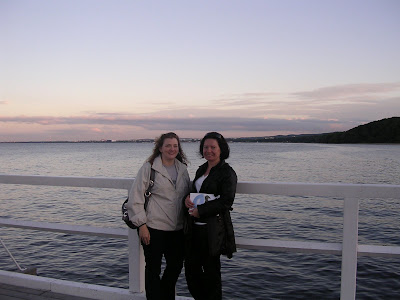Matt and I returned to Gdansk the week of August 4th-8th. He was there for work, of course, but I was looking forward to the Shakespeare Festival and Saint Dominic's Fair as well as sites that I did not see during my trip in the spring. We were staying in Gdansk this time, as opposed to Sopot in March. This was a great base for exploring the city and getting around, especially since our hotel was so close to the main train station and main shopping street.

Dominican Fair

Living Statues

This one is for the ADPIs!
On my list of things to see this time were The Roads to Freedom exhibit and the Westerplatte (where WWII began), mentioned in more detail below. I strolled through the Dominican Fair one day on my way to the waterfront. Old town was packed with street stalls, buskers, entertainers, and of course loads of tourists/bargain hunters. At the waterfront, I purchased a return ticket on one of the touristy pirate ships that takes visitors to the Westerplatte. The ride to the Westerplatte was about 30 minutes long and took us along the coast while the captain pointed out the Gdansk shipyard and many other interesting sites. I spent an hour on the Westerplatte before returning.
Entry to The Roads to Freedom exhibit

The pirate ship to Westerplatte
 Gdansk Shipyard
Gdansk Shipyard
Bunker on Westerplatte
One evening I made plans with my polish friend, Elzbieta, to see one of the Shakespeare Performances. We chose Romeo & Juliet being performed by Shakespeare's Globe Theatre in London. We chose an English performance since that was the only language I would be able to understand, although I was never quite sure how old English could translate to other languages. Also, the performance was set outside in a park in Gdynia. It wasn't your traditional stage performance, which made the production even more interesting. After the play, we strolled along the sea to Gdynia pier and then found our way to a Thai? restaurant for dinner. (My memory fails me now and can't remember if it was Thai or Indian or something.) We took the train back toward Gdansk and parted ways for the evening.
Me and Elzbieta "Ela"
It is always a pleasure joining Matt in Poland as I generally get to see his colleagues in the Gdansk office. I have formed a friendship with a couple of them, since they were on the original UK team and training here in Basildon last year. (The Shared Service Center in Gdansk is celebrating its one-year anniversary this month!) Ela is one of those special friends and I hope we can will remain in touch even after I return to the States.
To know more about items mentioned above, please continue reading. Excerpts taken from Gdansk In Your Pocket.
Roads to Freedom exhibit. Charting the course of events that began with the sacrifice of Poland to the Soviets at the end of WWII and leading through to the formation of the 3rd Polish Republic in 1989, this subterranean exhibition does a very good job of explaining the events that influenced and shaped the people of Poland and which resulted in the incredible movement that was Solidarity.
Westerplatte. A large protective arm smothering Gdanks's Nowy Port to its south, the peninsula of Westerplatte first sprang to fame as a popular health resort in the middle of the 19th century, although it's as a military zone and the place where the opening shots of WWII were fired that Westerplatte is more notoriously rememberd. Shortly before five o'clock in the morning on September 1, 1939, the gErman warship Schleiswig-Holstein, supposedly visiting Gdansk on a good-will mission, opened fire on Westerplatte, and the rest as they say is history.
Shakespeare Festival. August sees the annual Shakespeare Festival which has developed quite a tradition and reputation both in Poland and abroad. It begins on the first Saturday of August and is a tribute to England's great bard. In this 12th edition of the festival, artists from different cultures and continents from the UK to Japan, USA, France, spain, Romania, Armenia, Ukraine, Zambia and Poland met in Gdansk. The main events took place in Gdansk, including workshops, lectures and meetings, and as the nights wore on there were further meetings and concerts around the Tri-city.
Saint Dominic's Fair. The Dominican Fair is the largest outdoor trade fair in Oland, and drawing some 150,000 visitors daily it's also one of the most popular in Europe. The event dates from 1260 when Pope Alexander IV granted the Dominican Order the power to absolve the sins of whoever made donations to the church of the poor. This annual event soon became a religious hoiday for the people of Gdansk, and a trade fair soon built up around it.








 Romeo & Juliet stage
Romeo & Juliet stage Gdynia Beach
Gdynia Beach

